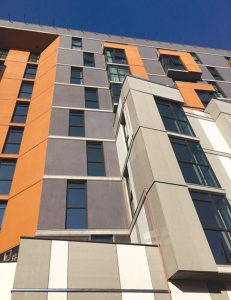Casa Adelante is a seismically resilient nine-story affordable housing project for low-income seniors, with 25% of the units reserved for formerly homeless seniors. The specially “tuned” reinforced concrete building uses self-centering walls on a rocking mat foundation. Lead extrusion dampers within the foundation control the seismic response. The building has been evaluated to have zero days of downtime for repair after a major earthquake, and the project received a Gold Rating from the US Resilience Council.
Mar Structural design immediately moved to make Casa Adelante structurally special when learning that the building would be 100% affordable, serving low-income seniors with 25% of the units set aside for formerly homeless seniors. The designers were compelled to make the nine-story reinforced-concrete apartment building seismically resilient to protect an economically vulnerable population who likely would have very limited resources. There were no illusions that there would be “extra” money from the non-profit developers for improved seismic performance. The reality is that more housing is significantly more important than better seismically performing housing in San Francisco. The region suffers an acute shortage of affordable housing. Mar Structural challenged itself to create affordable seismic resilience with this as context and constraint.
Conventional code-conforming buildings can sustain significant structural damage in the process of protecting the safety of the occupants during a major earthquake. However, damage can lead to loss-of-use and, in the case of the Casa Adelante residents, the potential for homelessness. However, some structural forms have intrinsic capacities that are untapped.
The approach for Casa Adelante was to utilize a cantilevered wall structure on a rocking mat slab foundation and “tune” it using non-linear response-history analyses (NLRHA) so that it would be strong, stiff, and capable of self-centering in a major earthquake. To create foundation rocking, designers balanced the strength within elements to get the building to re-align after an earthquake. Specifically, the resilient scheme employed the following steps: The formerly liquefiable site was strengthened with deep soil mixing, providing extra strengthening at the ends of walls to preclude soil failures and ensure rocking. The mat slab and the post-tensioned concrete floor plates were made relatively strong for positive bending and relatively week for negative bending. These arrangements allowed re-centering and just enough energy absorption. Two of the transverse walls needed to be located with one end adjacent to a property line. Four lead extrusion dampers were installed within the foundation and coupled to tension piers for these walls. The dampers activate during rocking and make up for the loss of slab yielding. The cumulative effect of these moves is a re-centering structure that avoids extensive residual drifts, expensive structural repairs, and potential loss-of-use during repair, which provides the opportunity for resilience.
Two schemes were developed to avoid a cost premium for the high-performance design – a conventional design and a high-performance design. This resulted in an internal competition. The conventional design established the baseline cost that the high-performance scheme could not exceed to be considered viable. The general contractor priced both schemes and found the high-performance scheme cost neutral. With evidence of the greater value of the high-performance scheme, Mar Structural presented the findings to the developers (CCDC and MEDA) and the San Francisco Mayor’s Office of Housing and Community Development. The team green-lighted the high-performance design.
Professor Geoff Rogers, from the University of Canterbury, was enlisted to develop the foundation dampers and apply his state-of-the-art technology to a real project and a great cause. He led the efforts to prototype, test, and produce the dampers while staying within tight cost controls. He also donated all his time to the project.
The San Francisco building department requires an expert peer review when using innovative technologies. Professor Greg Deierlein, from Stanford, was the project reviewer. His critical work was also provided pro bono.
Once Casa Adelante was designed and performing well, Mar Structural reached out to the US Resilience Council (USRC) and got them excited about the project. The USRC waived their fees and, after a detailed evaluation, they awarded the project a Gold Rating for resilience. Casa Adelante is the first multi-unit housing project rated by the USRC. We believe it is one of the first high-performance designs for under-resourced occupants constructed in the U.S. The San Francisco Office of Resilience and Recovery promotes resilient design and targets 40 days of repair and loss-of-use for buildings after a major earthquake. Casa Adelante is rated to have zero days of loss-of-use.
The high-performance and conventional schemes were evaluated for economic losses, using FEMA P-58, Development of Next-Generation Performance-Based Seismic Design Procedures for New and Existing Buildings, and the SP3 software (Haselton Baker Risk Group, LLC) that comprehensively assesses seismic damage, loss, and building repair time. The high-performance scheme was more valuable, yielding $500,000 (net present value) savings from earthquake losses.
Finally, the contractor performed a post-construction cost evaluation of the as-built structure against the conventionally designed benchmark. The results were an additional cost of $100,000 for the high-performance design for the $42 million project. The high-performance cost premium was near zero, with only 0.24% extra cost. Although the project slightly missed the cost-neutral target, the team was pleased with how close it was. The result is the resilient performance for affordable senior housing at a great value.■

